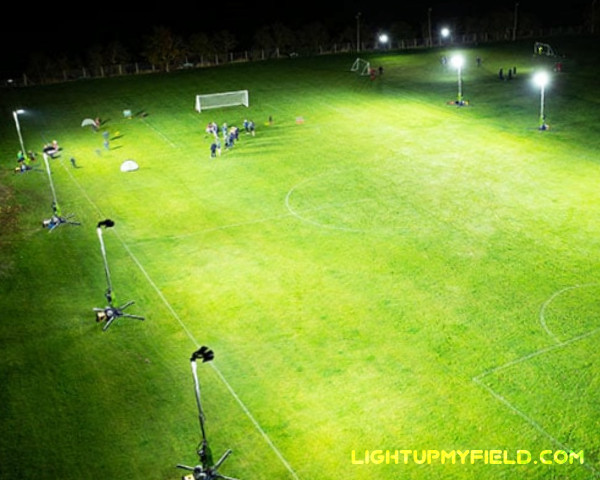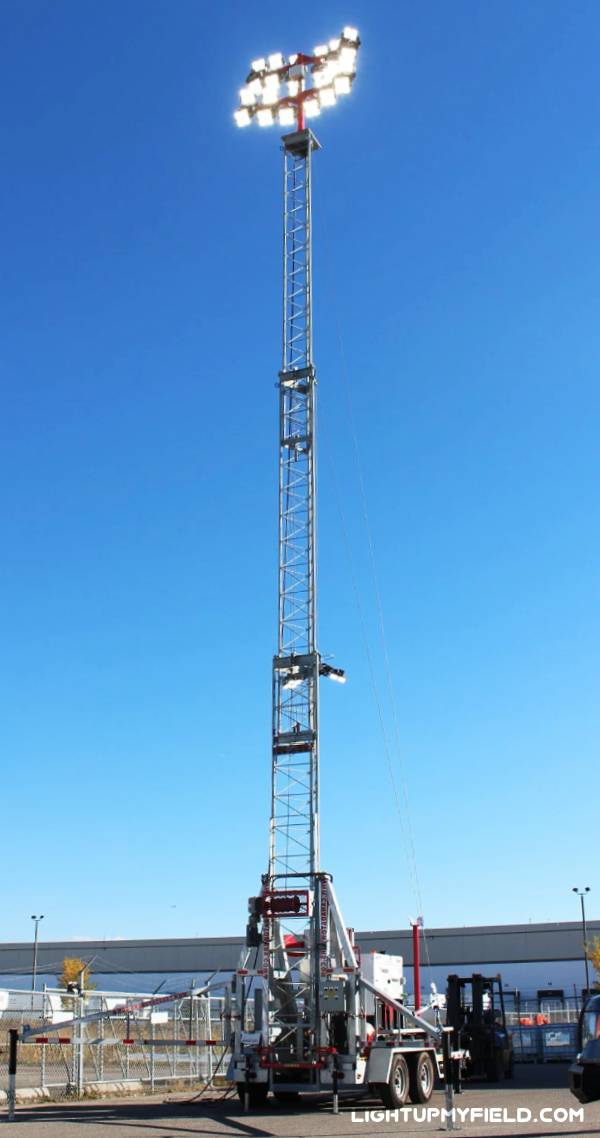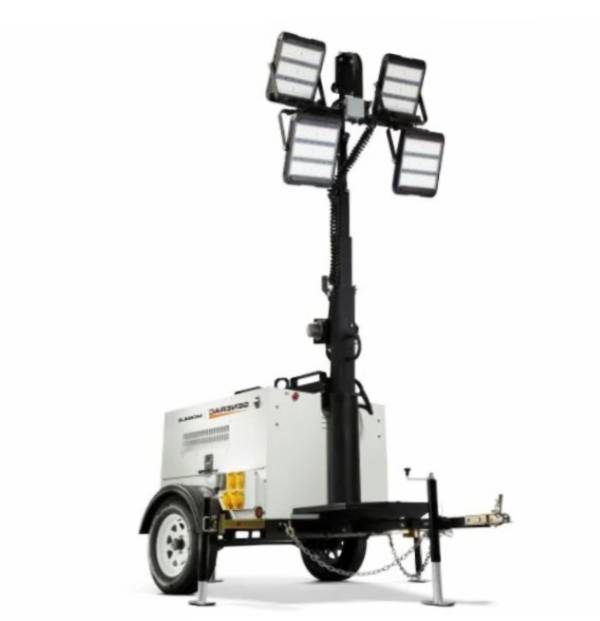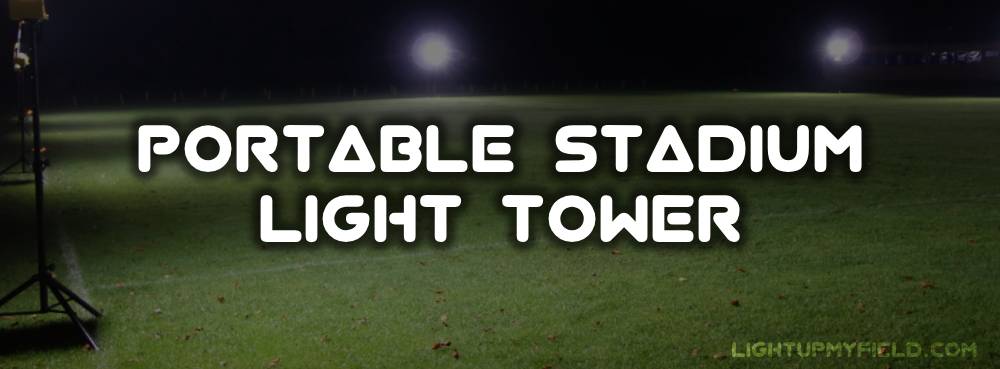When you’re dealing with night games, late practices, or outdoor events, good, bright, and reliable lighting can make or break the experience. While many stadiums have those tall permanent light poles, that’s not always an option for every field or event space. That’s where portable stadium light towers step in.
Think of them as a lighting solution you can take anywhere—almost like the SUV of stadium lights. But before deciding whether they’re right for you, it helps to understand what they are, what makes them tick, and when they make sense over a permanent setup.
Table of Contents
ToggleWhat exactly is a portable light tower for a stadium?
A portable stadium light tower is basically a mobile lighting system designed to flood large outdoor spaces—like football fields, baseball diamonds, or even concert venues—with high-intensity light. Unlike traditional fixed poles, these units are mounted on a trailer or wheeled base, making them easy to move from one spot to another.
They’re especially popular for temporary sports events, emergency setups after natural disasters, or seasonal fields that aren’t lit year-round. Imagine having a Friday night soccer match on a field that’s normally dark by 7 PM. Roll in a couple of these towers, fire them up, and suddenly you’ve got a bright, playable field.
Many modern versions use LED floodlights instead of old-school halogen lamps, which means you get more brightness with less power consumption. Some even come with solar options, which is a huge plus if you want to cut down on fuel use.
What makes up a portable stadium light tower?
 At first glance, a portable stadium light tower might just seem like a simple trailer with a tall pole and a few lights mounted on top. But when you take a closer look, you quickly realize it’s way more than that—it’s a complete lighting system made up of several important parts, all working in sync to flood a large area with bright, even light. Every single component has its own job to do, and if even one piece isn’t up to par or isn’t properly maintained, the entire setup can fall short, leaving you with uneven lighting or unexpected downtime. It’s this careful teamwork behind the scenes that makes portable light towers such reliable solutions for stadium and field lighting.
At first glance, a portable stadium light tower might just seem like a simple trailer with a tall pole and a few lights mounted on top. But when you take a closer look, you quickly realize it’s way more than that—it’s a complete lighting system made up of several important parts, all working in sync to flood a large area with bright, even light. Every single component has its own job to do, and if even one piece isn’t up to par or isn’t properly maintained, the entire setup can fall short, leaving you with uneven lighting or unexpected downtime. It’s this careful teamwork behind the scenes that makes portable light towers such reliable solutions for stadium and field lighting.
LED floodlights — the main powerhouse
The lights themselves are obviously the heart of the tower. These days, high-output LED floodlights have replaced most older halogen or metal halide lamps, and for good reason. A single LED light on a stadium tower can push out anywhere from 25,000 to 50,000 lumens, and with four to eight of these on one mast, you’re looking at a total output in the range of 100,000 to over 400,000 lumens. That’s bright enough to clearly light a full-size football or soccer field so players can see every pass, every run, and every detail.
LEDs also last a lot longer than older lighting tech—often over 50,000 hours of use before they start to dim noticeably. If you think about it, even if you used the lights for 5 hours a night, every single night of the year, that’s more than 25 years of life. Plus, LEDs use less power, which means your generator or solar system can run them longer without guzzling fuel.
Retractable mast — height matters more than you think
 The tower’s telescopic pole (or mast) is what gets the lights up high enough to spread illumination evenly. Most portable masts extend anywhere from 20 to 40 feet. That height makes a huge difference: the higher the lights are, the wider and more even the coverage. If you set them too low, you’ll get harsh shadows and bright “hot spots” that can mess with visibility.
The tower’s telescopic pole (or mast) is what gets the lights up high enough to spread illumination evenly. Most portable masts extend anywhere from 20 to 40 feet. That height makes a huge difference: the higher the lights are, the wider and more even the coverage. If you set them too low, you’ll get harsh shadows and bright “hot spots” that can mess with visibility.
The retractable design is practical too. When it’s fully lowered, the mast and lights fit neatly into the trailer, so you can tow the whole unit down narrow roads or even store it in a regular equipment shed. When you’re on-site, you just crank it up—some towers do this manually, others use a hydraulic or electric lift system—and you’re ready to go.
Generator — the engine behind the brightness
Unless you’ve got permanent power access at your venue, you’re going to need a generator on your light tower. Most portable stadium units have a built-in diesel or gas-powered generator tucked inside the trailer. For LED lighting setups, a decent-sized onboard generator can give you 8 to 12 hours of continuous light on a single tank. That’s perfect for back-to-back games, late-night events, or even overnight work.
Fuel efficiency here really matters—diesel generators often use about 0.5 to 1 gallon per hour depending on load. Over a whole season, that can save you hundreds of gallons compared to less efficient systems. Some towers also allow you to hook into external fuel tanks if you need them to run for days without stopping.
Solar and hybrid systems — cleaner and quieter
Not every portable light tower runs on fuel alone. There are now solar-powered and hybrid designs that combine solar panels with battery storage and a small backup generator. During the day, the solar panels charge up the batteries, and at night the stored power runs the lights.
A well-designed hybrid can cut fuel use by up to 70% compared to a traditional generator-only setup, and because the generator isn’t running constantly, it’s a lot quieter—something your neighbors or audience will thank you for. These systems are especially useful for remote areas where bringing in fuel is expensive or inconvenient.
Control panel — your lighting command center
A good control system makes the whole setup much easier to run. Most portable stadium towers come with a built-in control panel where you can switch lights on and off, adjust brightness if the system supports dimming, and sometimes set timers so the lights automatically shut off after the event.
Some newer models even have remote control capability via smartphone apps or wireless remotes, so you can manage the lights without walking over to the unit. That’s a small detail, but if you’ve ever had to cross a muddy field at 11 PM just to flip a switch, you know how much you’d appreciate it.
Portable field lighting vs permanent light poles
How permanent poles work
Permanent stadium light poles are the long-term, heavy-duty option. They’re built to last for decades, bolted deep into the ground, and wired straight into the local power grid. Because they can hold multiple high-power fixtures—sometimes eight to twelve per pole—they can deliver extremely even lighting coverage when installed by professionals. The trade-off is the price tag. Outfitting a full-size field with permanent poles can easily hit $200,000 to $400,000, and that’s before you even factor in months of planning, permits, and construction work.
The flexibility of portable towers
Portable light towers, on the other hand, are all about mobility. You can roll them in when needed, tow them to a different location the next day, and store them away when the season’s over. For multi-use venues or community spaces, this flexibility is huge. Imagine a park that’s a soccer field on Friday night, a concert venue on Saturday, and a food festival on Sunday—portable towers make that possible in a way fixed poles can’t.
Coverage differences in real life
Permanent poles almost always deliver more uniform light because they’re positioned at precise angles and heights for the specific field. Portable towers can still light a space effectively, but since they move around, you might need an extra tower or two to avoid dark corners or uneven lighting.
Power supply considerations
Another big difference is how they get their power. Permanent poles run off the grid, so once they’re in, you just pay the electricity bill. Portable towers rely on fuel or battery power, which means you’ll have ongoing operating costs. LED towers are pretty efficient—sometimes using only 0.5 gallons of diesel per hour—but it’s still something you’ll want to budget for if you’re using them often.
When portable wins
Portable towers really shine when permanent lighting just isn’t an option—whether because of zoning restrictions, short-term land use, or budget limits. They’re also great as an emergency backup for venues with permanent poles, so you’re not left in the dark if the main lights fail before a big event.
Where can portable light towers be used?
Portable stadium light towers are surprisingly versatile. As long as there’s enough space to set them up, they can handle an impressive range of sports fields and event spaces. Let’s look at how they fit into different setups and why they work so well in each one.
Football fields
American football fields measure about 120 yards long and 53 yards wide, which means they need strong, consistent lighting from one end zone to the other. Because of the speed and intensity of play, every tackle, pass, and run has to be clearly visible—not just for the players, but also for the fans and referees.
A good portable light tower setup usually involves placing towers along the sidelines, evenly spaced so the entire playing surface is covered without glare in the quarterback’s eyes. For high school or community-level games, four to six towers with LED floodlights pumping out 100,000–150,000 lumens each can easily create professional-grade lighting for the full 60 minutes of play.
Soccer fields
Soccer fields tend to be slightly wider than football fields, often up to 80 yards across. That extra width means spreading out the towers is even more important. For youth or amateur leagues, a layout with towers at the corners and along the sidelines can give goalkeepers the visibility they need to track long balls and keepers from getting lost in deep shadow.
For community matches, six well-placed towers are usually enough, but professional training sessions might go up to eight for perfectly even lighting. The nice thing is, you can easily re-position towers between halves or matches if you need to.
Baseball fields
Baseball is trickier to light because the action happens in multiple zones—the infield, outfield, and foul territory—and the ball moves fast. Portable towers work best when placed behind home plate and along the foul lines, creating a triangular coverage pattern.
A regulation baseball diamond covers about 400 feet from home plate to the outfield wall, so each tower needs to throw light far and wide without causing glare for batters. A setup with five or six high-mast LED towers can illuminate both the pitcher’s mound and the far corners of the outfield so fielders can react instantly to pop flies and line drives.
Cricket stadiums
Cricket matches often stretch into the evening, and in some formats like Twenty20 or one-day internationals, the final overs can finish well after sunset. Portable light towers are ideal for temporary cricket grounds because they can be placed just beyond the boundary rope, providing even coverage without distracting the batsmen or blinding fielders when catching high balls.
For a full-size cricket ground with a 150-meter boundary, eight to ten towers spaced evenly around the perimeter can create lighting similar to a permanent stadium setup—without the millions in installation costs.
Golf courses
While night golf isn’t common, it does happen for special events, charity tournaments, or at driving ranges. A golf hole can be hundreds of yards long, so lighting an entire course isn’t realistic for most situations. Instead, towers are typically used to light the putting greens, tee boxes, or driving ranges.
Because portable towers can be moved hole-to-hole, event organizers can shift them as players progress, keeping energy use efficient. For a driving range of 250 yards, two or three towers positioned behind the tee line can create enough light for players to clearly track their shots.
Tennis courts
For outdoor tennis venues without permanent lights, portable towers are an instant upgrade. A standard tennis court measures 78 feet long by 36 feet wide, so you don’t need massive towers—just enough to create uniform lighting that eliminates shadows and keeps the ball visible even during high-speed rallies.
Setting up towers at each corner is a common solution, and for tournaments that run late, they can be positioned slightly higher to improve the overhead light angle and reduce glare into players’ eyes.
Horse arenas
Equestrian arenas—whether for show jumping, rodeos, or dressage—often take place in large open areas that can be 100 by 200 feet or bigger. Riders need even lighting to judge distances and obstacles, and spectators want a clear view without squinting.
Portable light towers can be placed along the long sides of the arena to throw consistent light across the entire riding surface. Since many equestrian events run into the evening, having portable towers ready can mean the difference between finishing the competition or calling it off.
Is it worth buying stadium light towers?
 Whether a portable light tower is a smart buy depends on your situation. They’re not a one-size-fits-all solution, but in the right conditions, they can be a game-changer. Let’s look at some real-world scenarios where they make sense.
Whether a portable light tower is a smart buy depends on your situation. They’re not a one-size-fits-all solution, but in the right conditions, they can be a game-changer. Let’s look at some real-world scenarios where they make sense.
When permanent poles just aren’t an option
If your venue is on leased land or located somewhere with zoning restrictions against tall poles, permanent stadium lights might be off the table completely. In those cases, portable towers are pretty much the only practical way to host night games or events. You skip the months of paperwork, construction crews, and hefty foundation work—just tow them in, set them up, and you’re ready to go.
When flexibility is more valuable than permanence
Some venues aren’t just for one sport or one purpose. If your field doubles as a football pitch, a community fairground, and an outdoor concert space, fixed poles can’t always provide light exactly where you need it. Portable towers can be rolled into position for each event—Friday night football under bright LED beams, Saturday farmers’ market lit from the corners, Sunday night concert glowing under overhead floodlights. That kind of adaptability is hard to beat.
For seasonal or occasional events
If you only need lighting for a few months a year—like summer baseball leagues or autumn soccer tournaments—permanent poles may not make financial sense. They require year-round maintenance and electricity even when they’re not being used. With portable towers, you bring them out only when you need them. Over a decade, that could save tens of thousands in maintenance and utility costs.
As an emergency or backup plan
Even stadiums with permanent lighting sometimes face outages. Imagine your main lights failing an hour before kickoff—without a backup, the game is off, and so is the revenue from tickets, concessions, and sponsorships. A couple of portable towers stored onsite can save the day. They’re also invaluable for disaster relief or temporary event sites where power infrastructure is damaged or non-existent.
Crunching the numbers
A decent LED portable stadium light tower generally runs between $8,000 and $20,000, depending on brightness, mast height, and power source. For a small community field, you might need just four to six units for solid coverage—putting you in the $40,000–$120,000 range. That’s often half or less of what a permanent lighting system would cost, especially once you factor in installation and permitting.
LED tech also means lower fuel or power costs compared to older halogen or metal halide setups. Some towers sip as little as 0.5 gallons of diesel per hour, which can add up to big savings over a busy season.
Wrapping up on portable stadium light towers
Portable stadium light towers bring a lot to the table—mobility, quick setup, and the ability to light up spaces where permanent installations just aren’t possible. They might not always match the perfect, shadow-free coverage of permanent poles, but they’re versatile enough to handle a huge range of situations, from weekend soccer games to emergency flood relief.
Whether you’re a sports club, a community event organizer, or even a construction company working at night, having a few of these in your arsenal can open up new possibilities. If the choice is between a dark, unused field and one that’s buzzing under bright lights, the decision’s pretty clear.

